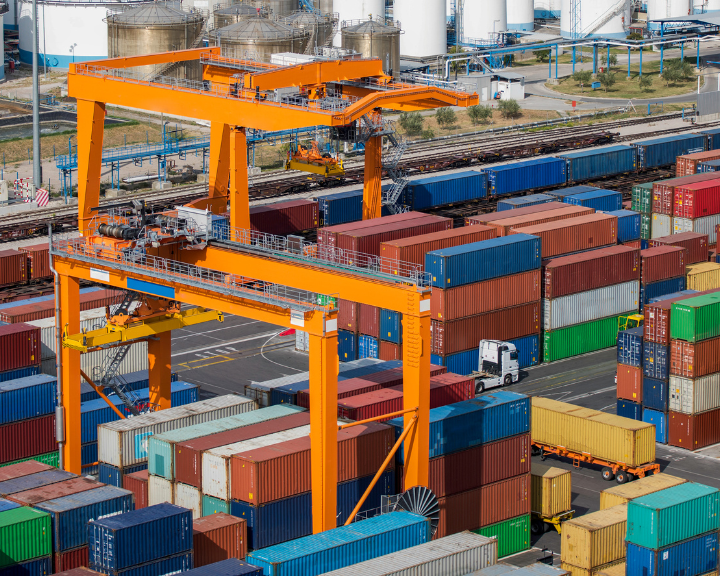We've done projects in weeks that our customers were told would take months. We finish integrations fast, freeing up resources to focus on innovation and service without bogging down internal IT teams.
Logistics API
API technology has been revolutionizing businesses in nearly every industry around the world, impacting our day-to-day lives. While the average person is interacting with APIs throughout the day, they may not realize it.
Some of the common mainstream applications of API include mobile apps that people use to book hotel stays, purchase products on Amazon, or confirm a reservation at their favorite restaurant — all from their smartphones.
That technology is now becoming mainstream among logistics companies. Logistics API has significantly transformed the logistics transportation and supply chain industry.
So, exactly what is an API? The acronym stands for an application programming interface. The API meaning for all industries is that it is a software intermediary, enabling information to be seamlessly shared among various technology platforms with varying architectures and coding. This means that one program communicates with another program.
As a result, the API logistics meaning can be translated into technology that allows logistics software platforms to communicate with each other, primarily enabling logistics companies to immediately share data related to route planning, location of vehicles, and other activity related to the logistics activities in the supply chain.
For many logistics companies, logistics API technology has replaced manual processes that have dominated the industry for decades. Instead of relying on telephones, fax machines, and other EDIs (electronic data interchanges) to communicate with shippers, carriers, and other partners in the supply chain, an increasing number of logistics companies are streamlining their operations through APIs that significantly expedite communications. These logistics APIs are an integral part of supply chain integrations.
Logistics API Integration
Logistic companies, including 3PLs, 4PLs, shippers, and freight forwarders, are leveraging logistic API integration solutions to inform decision-making and planning with more accuracy and consistency in real-time. The logistics API solutions can be customized to fit the needs of an individual supply chain partner, ensuring that users can be flexible and agile in performing to customer expectations, and gain efficiencies.
Some of the ways that the technology has benefited users include the following:
Real-time supply chain automation. With logistics API, logistics providers can gain real-time visibility into relevant information through automated systems. Through API, logistics operators can easily access real-time data to ensure that they are providing their customers with accurate shipping quotes. It also allows them to make decisions based on real-time data about equipment capacity, location of shipments, and freight issues.
Real-time route planning. API technology also allows logistics companies to improve shipping times, increase efficiencies, and realize cost savings by identifying and providing updates on shipping routes, changes in rates, weather patterns, and news events that could cause delays and other disruptions. Through shipping API integration and ocean freight API solutions, information is delivered to the logistics companies and operators in real-time.
Automate tasks. Logistics API also helps logistics companies simplify the manual tasks and processes involved in their involved operations. As a result, tasks like customer updates, shipment tracking, billing, warehousing, packing, and inventory data can be easily accessed and reviewed in real-time. Not only does it eliminate the need to manually input data, but the automation resulting from logistics API minimizes errors and saves the user time and money.
Improve customer relations. APIs allow users to easily access more data that gives them insights about customers' needs as well as provides them with real-time information about the ETA of shipments. And, by freeing up more time, APIs give logistics companies the opportunity to focus on other areas of their businesses, including analyzing ways to improve customer service and processes.
Logistics companies also are benefitting from advanced API solutions that are designed to address specific challenges and needs within the supply chain.
For example, Vizion API and other real-time transportation visibility providers offer solutions that give shippers and BCOs the ability to keep track of their ocean freight through data collection services. As a result, shippers can receive real-time information related to container tracking activity through integrations with their software systems. This system can provide tracking details related to container number, master bill of lading, and master booking — with updates provided every six hours.
Freightos API also provides solutions targeted to businesses through a digital booking platform for international shipping. The solution allows companies to easily switch among logistics providers to ensure that they are getting the best pricing and quality for a shipment. It also incorporates shipment tracking and documentation management as part of the solution.
Chain.io also allows logistics providers to optimize their systems through solutions that ensure the different technologies they are using can communicate with each other. Chain.io integrates APIs from various logistics systems, visibility providers, Cargowise, and other TMS' (Transportation Management Systems).
API Logistics Tracking
In recent years, businesses and logistics companies have increasingly focused on end-to-end visibility in the supply chain, especially in the wake of supply chain disruptions during the COVID-19 global pandemic.
Through solutions like API logistics tracking, container tracking API, multi-carrier tracking API, and order tracking API, logistics companies and businesses can more quickly respond to potential challenges caused by delays at ports, traffic congestion, and adverse weather.
With the modern supply chain involving multiple checkpoints and partners throughout a global network, API logistics tracking has been critical in ensuring that the flow of real-time data related to all phases of the supply chain is seamless and accurate.
For example, logistics companies using API can better manage and streamline their fulfillment processes, passing on savings to customers on shipping costs. They also can use APIs to improve the accuracy of shipping rates, select the most optimized shipping routes, and identify partners that align with their quality standards and budgets. Users of logistics API also can provide their customers with more accurate information related to the status of product shipments, including potential delays and ETAs.
Container APIs enable logistics providers to improve their tracking of ocean containers. Coupled with container tracking technology, companies can introduce that data into their network with the use of APIs. The resulting real-time tracking allows users to gain real-time visibility into all stages of the shipment.
The purpose of logistics tracking API also is evident in companies like UPS and DHL, two of the leading multi-national shipping and supply chain management providers in the world. By using the companies' API solutions, eCommerce companies can gain access to a wide range of API-driven shipping services, giving them the ability to ship and track their orders worldwide.
For example, DHL’s services include freight forwarding, domestic shipping, customs, and tax clearance, as well as fulfillment services like warehouse and inventory management. The company’s freight forwarding services include air, ocean, land, and rail freights.
What is EDI in Logistics?
When researching solutions, logistics providers may want to consider an API vs. EDI comparison. Both have the same goal of connecting systems but operate differently in their applications.
What is EDI? EDI, which stands for Electronic Data Interchange, is a technology that has been around since the 1970s. EDI works by establishing a connection to a secure peer-to-peer network, then standardizing data from massive quantities of physical documents, such as invoices and order forms. It then processes the data into an electronic format that can be used in business interactions. As a result, the answer to another question — What is EDI in logistics? can be answered by noting that it minimizes the need for manual data input, streamlines processes, and minimizes errors.
Many users of EDI platforms consider the security features, ease of use, and prevalence of use throughout various industries as among their leading advantages. However, some businesses are concerned that EDI technology may be too outdated when it comes to compatibility with newer technologies such as blockchain.
With API or Application Programming Interface, companies can achieve similar goals as EDI with their processes. However, EDI establishes a connection between two EDI systems, while API represents a web-based protocol — cloud-based technology — that allows systems with different technologies to communicate with each other.
Technologies like freight API and logistics API have been adopted by many of the leaders in various industries, such as Amazon, DHL, and UPS. API allows for real-time access to big data, giving users the ability to be more nimble and agile in their operations.
Maersk API
When it comes to transporting goods in a fast-paced digital era, logistics companies want to ensure that they have access to real-time data. Some are investing in Maersk API software to gain numerous solutions to integrate data from multiple points across their supply chain.
Maersk tracking solutions also allow users to gain real-time visibility so that they can address supply chain inefficiencies at various stages.
Some of the benefits Maersk promotes include:
- Faster real-time data exchange that allows users to make quicker and more informed decisions.
- Data automation capabilities automatically synchronize the sharing of data across applications, which speeds up business processes.
- Easy implementation that seamlessly integrates with existing business systems.
- Minimizes risks of errors through the secure exchange of information with minimal manual processes.
FedEx API
Founded in 1971, FedEx is among the largest global companies providing transportation, e-commerce, and business services. The company includes four divisions — FedEx Express, FedEx Ground, FedEx Freight, and FedEx Services.
Through FedEx Express, the company offers shipping services for packages and freight. In recent years, it has advanced its capabilities through FedEx API and FedEx API key, As a FedEx API example, the FedEx Freight segment provides customers with less-than-truckload and other freight delivery services.
As part of the FedEx Services segment offerings, customers gain solutions that focus on sales, marketing, customer service, information technology, communications, and billing and collection services.
Prospective customers can explore a FedEx API tutorial online to gain insights into their system.
Cargo API
Cargo API is among the vessel tracking systems represented by different types of API in logistics solutions.
Leading travel companies have invested in solutions, such as Delta Cargo API and United Airlines API, to increase revenue, improve customer service, automatically scale cloud services, and enhance flexibility in their application's ability to interact with other services.
For example, the Delta Cargo API enables its customers to send and receive requests directly from their own systems. As a result, companies can search Delta flights and current rates, create and manage bookings from their systems, and track shipments.







